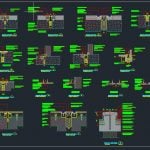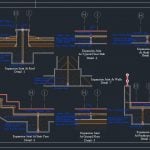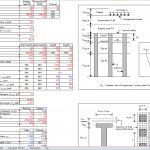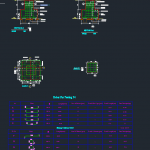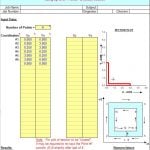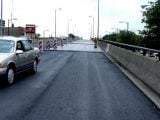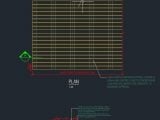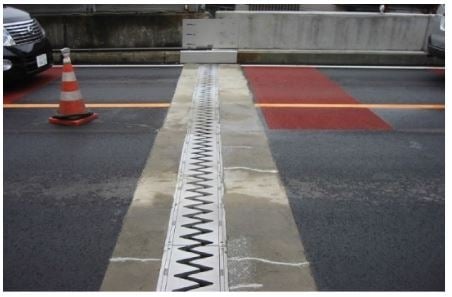
Bridge Expansion Joint Functions and Dynamic Behavior
20 February 2020Bridge Expansion Joint Functions and Dynamic Behavior
1. Functions of Expansion Joint
Bridge expansion joints are designed to adjust its length accommodating movement or deformation by external loads, shrinkage, or temperature variations, and allow for continuous traffic between bridge structures and interconnecting structures (another bridge or abutment).
The expansion joints can also be used for reducing internal forces in extreme conditions and allow enough vertical movement for bearing replacement. Steel expansion joints are most commonly used, though rubber joints are also often used to provide a smooth transition for modern bridge construction, or continuous girders (Toma et al., 2005).
It was suggested that expansion joints fall into three broad categories depending upon the amount of movement accommodated (Malla and Shaw, 2003), including:
(1) small movement joints capable of accommodating movement up to about 45 mm
(2) medium movement joints capable ofaccommodating total motion ranges between about 45 mm and about130 mm
(3) large movements joints include systems accommodating total motion ranges in excess of about 130 mm.
There are many different types of expansion joints according to JASBC (1984), such as blind type, slit plate type, angle joint type, post fitting butt type, rubber joint type, steel-covered plate type, and steel finger type. According to ICE (2008), there are buried joints, asphaltic plug joints, nosing joints, reinforced elastomeric joints, elastomeric in metal runners joints, and cantilever combor tooth joints. Some examples of expansion joints used in bridge structures are shown in Fig.1.

Fig.1. Different bridge expansion joints.
Expansion joints should be installed as late as possible in bridge constructions allow for shrinkage, creep, and settlement movements to have taken place. Similar to other semi permanent members, the expansion joints should be designed so as to be easily replaced or reset in service stage.
2. Dynamic Behavior of Bridge Expansion Joints
If a bridge is subjected to a dynamic moving load, the response varies withthe time. Until recently, the dynamic requirements of bridge expansion joints to be taken into consideration were relatively less important.The design methods of the expansion joints were meant to deal with the structural problem in statistical terms by using the so-called dynamic factoror impact factor.
The role of expansion joints is to carry loads and provide safety to the traffic over the gap between a bridge and an abutment or between two bridges. A further requirement is a low noise level especially in densely populated area.
Therefore, expansion joints should be robust and suitable for static and dynamic actions. Movements of expansion joints depend largely on the size of the bridges and the arrangement of the bearings. In design phases, expansion joints are required to have movement capacity, bearing capacity for static and dynamic loading, water-tightness, low noise emission, and traffic safety.
On the basis of the fact that the failure due to impact loading is the main reason for the observed damages, we shall focus our attention to the impact factor for vehicle load that is governed by traffic impact because it differs from the static loading.
The cantilever-toothed aluminum joint (finger joint) is one of the promising joints under impact loading to overcome this difficulty. From the viewpoint of design methodology, numerical studies for impact behavior were conducted for aluminum alloy expansion joints withperforated dowels. The design impact factor for the expansion joints with the perforated dowels against traffic impact loading was examined by using numerical simulations, in which the dynamic amplification factor defined as the ratio of dynamic to static response was compared at various input-load patterns to the factors for expansion joints (Figs.2. and 3).
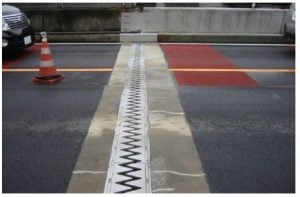
Fig.2. Bridge expansion joint
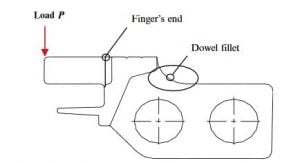
Fig.3. Aluminum alloy expansion joints
The mechanical characteristics can be considered as indicators of the dynamic behavior so that the durability of an expansion joint is nothing more than the maintenance of performance in time. The value of frequencies and damping of the different modes is the main indicator. In laboratories, these characteristics can be more or less simulated, but the correlation with the situ behavior is not so easy. More precise methods of impact effectcontrol must be established to facilitate the appreciation of the stage of the cumulative damage.

